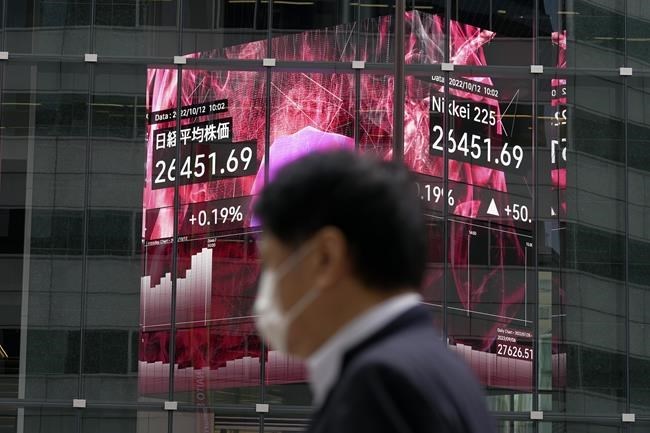NEW YORK — Stocks ended a wobbly day lower on Wall Street after a late-afternoon drop erased the tentative gains major indexes had been clinging to for much of the day. The S&P 500 gave back 0.3% Wednesday, its sixth consecutive loss. The Dow and Nasdaq ended with smaller losses. Yields on the 2-year and 10-year Treasury notes ended lower. Stocks had waffled between gains and losses for much of the day as traders parsed a report from the government that showed inflation at the wholesale level eased last month, though it was a bit worse than expected. Crude oil prices fell.
THIS IS A BREAKING NEWS UPDATE. AP’s earlier story follows below.
Stocks edged higher, though trading remain unsettled on Wall Street Wednesday after a report showed that inflation remains very hot.
The indexes were little changed following the release of the minutes from the Federal Reserve's last interest rate policy meeting. The minutes show Fed officials stressed their commitment to taming “unacceptably high” inflation before announcing another hefty interest rate hike and signaling more large rate increases ahead.
“The Fed minutes didn’t contain a lot of new information, but they did reiterate their intention to erring on the side of doing too much, rather than too little," said Chris Zaccarelli, chief investment officer at the Independent Advisor Alliance.
The S&P 500 rose 0.1% as of 3:35 p.m. Eastern. The index was roughly evenly split between gainers and losers. Different sectors have the market have been alternating between leading and lagging throughout the day.
The Dow Jones Industrial Average rose 84 points, or 0.3%, to 29,324, and the Nasdaq rose 0.3%.
Treasury yields, which have driven much of Wall Street’s recent trading, eased modestly. The yield on the 10-year Treasury, which affects mortgage rates, fell to 3.91% from 3.95% late Tuesday. It had been at 3.92% before the release of the Fed meeting minutes. The yield on the 2-year Treasury held steady at 4.30%.
Gains in consumer goods companies, energy stocks and retailers helped keep losses elsewhere in the market in check. Kroger rose 1.2%, Occidental Petroleum rose 2% and Starbucks added 1.1%.
PepsiCo rose 4.3% after raising its profit forecast for the year following encouraging quarterly financial results.
Cruise line operators were among the biggest gainers in the S&P 500. Carnival rose 10.7%, Norwegian Cruise Line gained 11.8% and Royal Caribbean climbed 11.6%.
Markets have been volatile all week as investors wait for the latest round of big company earnings reports and fresh reports on inflation and retail sales. The benchmark S&P 500 is coming off five straight losses and is close to its lowest point in nearly two years.
A report from the government showed that inflation at the wholesale level eased last month, though it was a bit worse than economists expected. A more closely watched component of the inflation data matched economists’ forecasts.
Inflation updates are being closely watched by investors who worry that stubbornly high prices on everything from food to clothing could lead to a recession. Those worries have been worsened by central banks around the world raising interest rates to make borrowing more expensive and slow economic growth.
The Federal Reserve has been particularly aggressive, and its strategy carries the risk of stalling an already slowing economy and causing a recession.
In the minutes from the central bank's Sept. 20-21 meeting, Fed policymakers judged that a “softening of the labor market’’ — likely including higher unemployment — would be needed to curb the nation’s inflationary pressures. They noted that hiring remained “robust,” which itself fuels high inflation as wages rise sharply.
A closely watched report on consumer prices is due Thursday and data on retail sales for September is due Friday. Both reports could help give Wall Street a clearer picture of where prices remain hottest and how consumers are reacting.
The corporate earnings season begins in earnest this week. Domino's Pizza and Walgreens will report their results on Thursday. Big banks, including Citigroup and JPMorgan Chase, will report results on Friday.
The British pound weakened against the U.S. dollar after the governor of the Bank of England, Andrew Bailey, confirmed the bank will not extend beyond Friday an emergency debt-buying plan introduced last month to stabilize financial markets.
Markets in Europe were mostly lower.
The U.S. dollar has been gaining strength relative to other currencies amid increased recession fears. The Japanese yen declined to a 24-year low against the U.S. dollar to 146 yen-levels, raising expectations of an intervention to prop up the yen following one such move in September.
Damian J. Troise And Alex Veiga, The Associated Press


